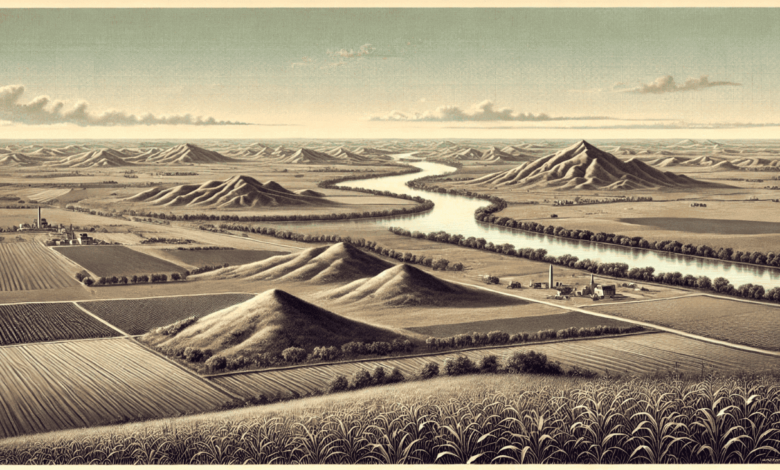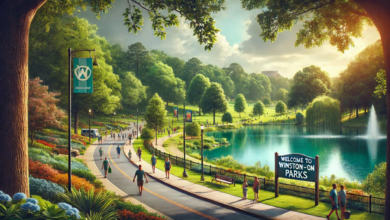Does Des Moines Have Rolling Hills or Just Flat?

When it comes to the landscape of Des Moines, Iowa, many people often wonder, does Des Moines have rolling hills or just flat terrain? Is it the flat plains that are so often associated with Iowa, or does the city feature some variation in its geographical features? In this article, we’ll take a deep dive into Des Moines’ topography and explore whether it has any rolling hills or if it’s simply flat.
The Flat Landscape of Des Moines
Des Moines, like much of central Iowa, is known for its flat terrain. The area’s geography was heavily influenced by the Wisconsinan Glaciation, which occurred around 10,000 years ago. As glaciers advanced southward, they flattened large sections of land, leaving behind fertile soil that would later become ideal for agriculture.
In fact, if you drive through Des Moines or look at the city’s general layout, you’ll see that much of the area is flat, especially near the Des Moines River. This flatness makes the area perfect for farming, with vast stretches of land dedicated to crops like corn and soybeans.
So, when people ask, does Des Moines have rolling hills or just flat, the answer for the city proper is largely flat, especially in the downtown area and nearby districts.
Rolling Hills Around Des Moines
However, the flat terrain of Des Moines doesn’t mean that the entire metro area is devoid of hills. In fact, some areas surrounding the city contain rolling hills. These hills are not as steep as mountain ranges, but they do create a more varied landscape compared to the city center.
To the west and south of Des Moines, for example, you will find more noticeable undulating terrain. These areas contain glacial remnants such as terminal moraines, which result in the gentle rolling hills seen in the outskirts of the city.
While Des Moines itself is primarily flat, the surrounding areas provide a more diverse landscape, making the transition from flat plains to rolling hills a smooth one as you move outward from the heart of the city.
The Des Moines Lobe: A Geographical Key
A key element in understanding whether Des Moines has rolling hills or just flat land is the concept of the “Des Moines Lobe.” This lobe refers to the portion of the Wisconsinan glacier that extended into central Iowa, leaving behind both flat plains and gentle hills.
While the Des Moines Lobe is responsible for much of the city’s flat terrain, areas outside the city proper—such as West Des Moines, Clive, and Johnston—reveal more rolling topography. In these outer areas, the gradual hills provide a scenic contrast to the city’s predominantly flat landscape.
The Influence of the Des Moines River
Another geographical feature of Des Moines is the Des Moines River. While the river itself doesn’t create dramatic hills, it does carve out subtle elevation changes along its banks. As the river runs through the city and its outskirts, the terrain gently rises and falls, contributing to a mild variation in the landscape.
These small changes in elevation can be seen more clearly as you venture east or west of Des Moines. Though the riverbanks don’t create large, rolling hills, they do offer a sense of undulation in the otherwise flat plains, making the area’s geography more interesting.
What Makes Iowa’s Landscape Unique?
While much of Des Moines is flat, it’s important to note that the state of Iowa features more varied terrain. To the west of Des Moines, the Loess Hills—a dramatic range of hills made from wind-deposited soil—offer much steeper and more pronounced slopes than anything found within the metro area.
The rolling hills around Des Moines are nowhere near as dramatic as the Loess Hills, but they still provide a pleasant variation to the otherwise flat plains. These areas surrounding the city offer a gentle undulation that enhances the rural beauty of central Iowa.
The Verdict: Flat With Some Rolling Hills
So, does Des Moines have rolling hills or just flat terrain? The answer is a bit of both. While the city itself is primarily flat, especially in its central and downtown areas, you don’t have to travel far to find gentle rolling hills. These mild undulations are scattered around the Des Moines metro and surrounding areas, particularly as you move out toward the river or into more rural parts of the region.
FAQs About Des Moines’ Terrain
Is Des Moines completely flat?
Des Moines is mostly flat, especially in the downtown area, due to the glacial deposits left by the Wisconsinan Glaciation. However, there are areas outside the city with mild rolling hills.
Where can I find rolling hills near Des Moines?
You can find rolling hills to the west and south of Des Moines, in areas like West Des Moines, Johnston, and Clive. These hills are a result of glacial remnants such as terminal moraines.
Does the Des Moines River affect the city’s landscape?
Yes, the Des Moines River creates slight changes in elevation along its banks, contributing to mild undulations in the landscape, especially to the east and west of the city.
Are the rolling hills in Des Moines steep?
No, the hills around Des Moines are generally gentle and not steep. They offer a mild variation in terrain, providing scenic beauty without the steep inclines of mountain ranges.
Conclusion
In conclusion, does Des Moines have rolling hills or just flat land? The city itself is predominantly flat, but the surrounding areas offer gentle rolling hills, making the landscape more diverse. These hills, while not steep or dramatic, provide a pleasing contrast to the otherwise flat plains that dominate central Iowa. Whether you’re hiking around the outskirts of Des Moines or simply enjoying the view, the region offers a varied landscape that’s both unique and beautiful.


